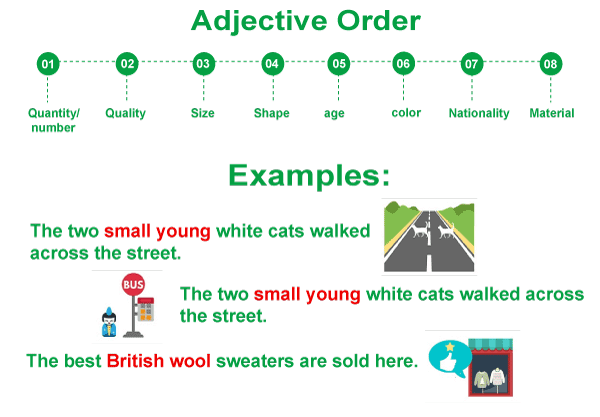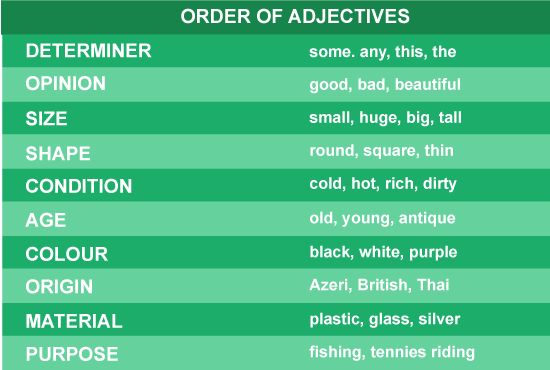Order Of AdjectivesDo you enjoy describing things, animals, people, and all that's around you? If you are, you probably know a lot of adjectives, but are you sure you're using them correctly? Yes, you read that correctly. When more than one adjective is utilized to describe the same subject or object, they must be written in a specific order. This article on adjective order will teach you how to correctly arrange adjectives in a phrase. Check out the examples for a better understanding. Adjective Types: Objective and SubjectiveThe English language, without a doubt, is a language of exception and modifications. However, some rules control the order of adjectives, ensuring that each adjective has its rightful place in respect to the noun. It is worth noting that adjectives are classified into two types: objective adjectives, which convey facts, and subjective adjectives, which convey somebody's opinion. The first group of words convey factual information about something. In other words, it's impossible to argue with. This can include things like size, color, age, and so on. Words in the second set of adjectives, on the other hand, indicate how someone views this or that object (individual, thing) and their opinion regarding it. Order Of Adjectives : OverviewWhenever someone uses more than one adjective prior to a noun in English, the adjectives are frequently used in a precise sequence. It can sound weird if the adjectives are not in the correct order. However, there are two points to consider.

For example, look at this sentence "Every Saturday, my granny makes an Asian big supper,". This sentence is technically right-it's large supper, it's Asian food, and it's made by the granny. However, it does not sound quite right, and that's due to the fact that the adjective order in that statement is incorrect. Most kids learn adjective order by listening and reading rather than through classroom instruction. Since the rules for adjective order in English are more explicit than in other dialects, putting adjectives in a specific sequence sound "right," and diverging from that order makes a sentence seem "wrong," even if it is grammatically correct. Adjective order in English Grammar The English language allows its users to employ a variety of adjectives to describe anything they are able to observe with their five senses. However, there is a specific order in which these adjectives should be employed in a phrase. Let's have a look at how it works. In English Language, the right sequence for adjectives is called as the Royal Order of Adjectives. The following is the Royal Order of Adjectives: 1. Determiner (Although not an adjective, determiners encompass article, possessive, and demonstrative) are included in the Royal Order of Adjectives. Adjectives and the nouns they alter must always appear before them.) Then, your, our, these 2. Quantity One, seven, six, five, many, and few. 3. Opinion In general, an opinion adjective expresses your feelings on something (others may disagree with you). Tasty, brave, foolish, beautiful, lovely, and priceless. This group is sometimes separated into two parts: broad and specific opinion, with broad or general opinion coming first. For instance, you could advertise a certain iPad as a popular and ideal choice for graphic designers. The overall opinion here is that it is well-liked, and this is an opinion shared by many. The more precise opinion is that it's ideal for digital illustrators-this is your personal view, but it may not be as generally held as the public one. 4. Size Adjectives which defines a noun's factual or objective nature. Of course, a size adjective indicates how big or little something is. Big, teeny-tiny, average, huge, small, tiny, and little. 5. Age An age adjective (adjective that denotes age) indicates how young or old a thing or individual is. Fresh, young, old, half a century old, second-newest 6. Shape A shape adjective describes how something looks. Circular, square, spherical, triangular, rectangular 7. Color A color adjective (adjective indicating color) reveals the color of something. Purple, white, yellow, orange, and Green 8. Origin/materials Denominal adjectives indicating the origin of a noun. An origin adjective describes the source of something. Whereas material denotes what it is made up of. Asian, Italian, steel, wooden, iron, cotton, silk, African, Russian 9. Qualifier The final limiter is frequently treated as part of the noun. A purpose adjective describes the function of something. These adjectives frequently end in "-ing" but it is not necessary. Sleeping tent, running shoes, Dracula bat, hound dog, leather skirt, sleeper cab Although you might not have seen the right adjective order presented in this manner before, you may have picked it up and implemented it without even realizing it. This order is naturally followed whenever more than one adjective is used to describe a noun, regardless of where those adjectives belong within the Royal Sequence. 
Have a glance at the following table to determine how various noun phrases are organized in the Royal Order; 
Notice how, even if you don't use an adjective from each group, you still employ this order? Even if you have a precise adjective order to maintain, there are times when you need to vary the order to adequately explain your message. One of these situations is when one of your sentence's adjectives is part of a compound noun. Consider the following example: He relocated to a brand-new big home. However, this sentence should read, "He relocated into a big brand-new home," as per the Royal Order of Adjectives, right? Yes, if you're referring to a relatively bigger new home. However, if you're referring to a big home, the answer is no. There are numerous ways in which English might be perplexing, and in certain cases, there is a hidden logic behind it. Why do adjectives have to be in this particular order?It's an unsatisfactory reply, but it's the only one: we don't know. There are, however, some theories. One is that the nearer an adjective is to its noun, the more important it is in describing the noun. Describing a house as a "wooden house," for instance, is more precise than describing it as an "ancient house" or a "lovely house." Although, this theory is not necessarily the most accurate or the precise one. To provide another example, consider the terms "big dog" and "brown dog." Is it true that a brown dog is a more particular description than a big dog? Like other oddities of the English language, Adjective order is something you just have to accept. 
The Use of Commas with AdjectivesWhen multiple adjectives are in a statement, some require commas while others do not. Isn't it confusing? It's absolutely not that terrible; there is a logic to this one.
As an example:
When you combine these statements with some adjectives, you get:
If you're unsure whether to use a comma, try this simple trick: if you can add the word "and" in-between adjectives and invert the order of the adjectives without compromising the sentence's coherence, you wouldn't require a comma.
How to Select English Adjectives CorrectlyThinking how to use the adjectives correctly, using order of adjectives. For instance; "A gorgeous large warm trendy oval blue European stainless steel sports mug" is quite a big phrase with numerous adjectives. That is why it is critical not to overuse adjectives. Numerous adjectives send a mixed message to readers and listeners. Instead, concentrate on memorizing where each category goes so that when you require one, you know precisely where to put it. Consider the following example: A gorgeous large newly opened blue British water swimming pool. Not all of these adjectives apply. We all know swimming pools are formed of water and are blue. Mugs/ cups, on the contrary, can be manufactured of any material and in any color. Using an adjective to describe the color of a coffee mug provides the listener or reader with new information. This is important information. It is required for them to form a more detailed visual image in the mind. As a general rule, aim to limit your adjective selection to two, three, or four adjectives that will provide the most detail to your statement. Once you've decided on a few adjectives, simply arrange them in the sequence listed above.
For better grasp and understanding of the topic, always study and observe writings or speech in English by native English speakers. As you read and listen, you will be able to build your vocabulary and start the correct placement of order of adjectives on your own. How Sentence Placement Affects Adjective OrderAdjectives come prior to the noun they describe or alter in a phrase. Usually. Consider the following sentence: The stage show was boisterous and packed. In this statement, they come after the verbs ("to be," that is in the past tense here: was). The sentence can be readily rewritten as follows: It was a boisterous, packed stage show. Both are true. However, when your adjectives come after your verb, as in the instance above, they do not satisfy the same comma restrictions as to when they come before your noun. When the final word in a phrase, clause, or sentence contains an adjective, it must be followed by "and": Her cat was tiny and black; it was a Persian. When there are three or more adjectives, the comma position is determined by whether your style comprises the Oxford comma, often called as the serial comma. If the Oxford comma is not used, each adjective preceding the second-to-last one must be distinguished by a comma: Their home is small, cramped, and contemporary. If you're using the serial comma, split each adjective with a comma: Their home is small, cramped, and contemporary. As an example:
While there are two or more adjectives from the similar category, the term and is put in- between them:
Suppose there are three or more adjectives from the same adjective group, then in that case a comma should be included in- between every coordinate adjective:
A comma should not be used between an adjective and a noun. 
Here are some more examples. These will help you better understand the concept of the order of adjectives.
Note: However, the precise sequence of adjectives is not agreed upon by all grammarians, and the detailed rules are difficult. The criteria apply to adjectives in their "natural" order. These standards are not restrictive, and you might just wish to modify the order for emphasis on occasion. Consider the following discussions:Dialogue 1:
Dialogue 2
ConclusionThis concludes the topic of Order of Adjectives. Thus, using more than three descriptive types of adjectives in succession to describe a single word or pronoun seems unnatural or complex. As a result, always limiting the number of adjectives and adhering to the right order of adjectives in English is unquestionably worthwhile. Happy Learning!
Next TopicAdjective Exercises
|
 For Videos Join Our Youtube Channel: Join Now
For Videos Join Our Youtube Channel: Join Now
Feedback
- Send your Feedback to [email protected]
Help Others, Please Share









